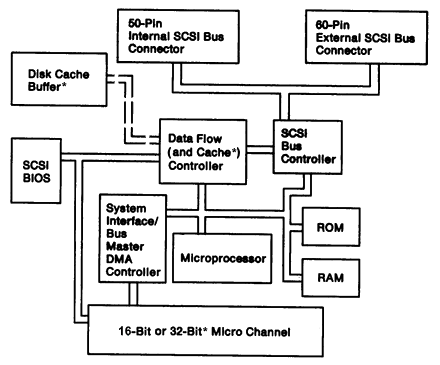|
Introduction
Block Diagram
Components
System Interface/Bus Master DMA Controller
Data Flow Controller (uncached only)
Cache and Data Flow Controller (cached only)
Disk Cache (cached only)
SCSI Bus Controller
Adapter Microprocessor
Adapter BIOS and POST
Implementations
Sources
Introduction
The IBM SCSI subsystem serves as the interface between the Micro
Channel Architecture (MCA) bus and devices using Small Computer System
Interface (SCSI). The subsystem supports:
- Abroad range of internal and external SCSI devices.
- Up to seven SCSI physical devices. Each physical device can
support eight logical devices.
- Overlapped command processing for up to 15 devices.
- Devices compatible with SCSI Common Command Set.
- A data transfer rate of up to 5 MB/s from the adapter to SCSI devices.
- A data transfer rate of up to 8.3 MB/s (uncached) or 16.6 MB/s (cached)
to the MCA host (burst).
- A 16-bit (uncached) or 16/32-bit automatically configurable data bus
(cached).
- A 24/32-bit automatically configurable address bus.
The adapter also serves as a bus master (intelligent bus controller).
Block Diagram

* Cached adapters only
Components
System Interface/Bus Master DMA Controller
The system interface/bus master DMA controller provides the command and
interrupt registers. These registers receive commands from the system and
interrupt the system when a command is completed. The transfer of data between
the adapter and the system is controlled through bus master DMA.
16-bit adapters w/o cache support data transfers up to 8.3 MB/s (burst).
32-bit adapters w/ cache support data transfers up to 16.6 MB/s (burst).
All implementations use the 33F6715 SCSI MCA iface/BM DMA controller.
Data Flow Controller (uncached only)
The data flow controller manages the flow of parallel data between the SCSI
bus and the system. The controller allows concurrent data transfers between the
SCSI bus and the Micro Channel.
The bus-steering and data-flow logic allows either byte or word transfers to
the system, and performs these transfers in the burst mode.
All uncached implementations use the 33F6910 SCSI Data flow controller.
Cache and Data Flow Controller (cached only)
This is a more advanced version of the Data Flow Controller above.
The cache and data flow controller manages the flow of parallel data between
the cache, the SCSI bus, and the system. The controller allows concurrent data
transfers between the cache and the following:
- The SCSI bus
- The Micro Channel connectors
- The adapter microprocessor random access memory (RAM).
The bus-steering and data-flow logic allows either byte, word, or doubleword
transfers to the system, and performs these transfers in the burst mode.
All cached implementations use the 15F6903 SCSI Cache/data flow
controller.
Disk Cache (cached only)
The disk cache keeps frequently-used SCSI device data available for
immediate transfer to the system. The disk cache also holds data until it can
be transferred to the system by the system interface/bus master DMA controller.
The disk cache is organized as 256K by 18 bits, including two parity bits, for
a total of 512 KB*.
The cache memory can be implemented in a number of ways:
- 2x 30-pin 256Kx9 (or 1Mx9*) parity SIMM
- 4x 256Kx4, 2x 256Kx1 DRAM
- 6x 256Kx4 DRAM (two devices used as 256Kx1 for parity?)
- 1x 256Kx18 DRAM
* Cached adapters with SIMM sockets ("Spock", "Spock Prime" and 7568
DASD) unofficially support a 1M by 18 bits configuration for a total of 2 MB of
cache memory.
SCSI Bus Controller
The SCSI bus controller transmits commands, receives status, transfers data
between attached SCSI devices and the adapter, and provides the following
functions:
- SCSI bus arbitration
- Device selection and reselection
- SCSI phase change detection
- SCSI bus parity generation and checking
The SCSI bus interface can be implemented in two different ways:
Adapter Microprocessor
The adapter microprocessor controls all adapter operations. It translates
commands received from the system into a series of operations. For example, the
adapter microprocessor manages the disk cache, controls data transfers to and
from the system, and executes all necessary error detection and recovery
procedures to ensure data integrity.
Two different microprocessor types are used:
- 16-bit adapters w/o cache: Intel 8032/80C32 or compatible
- 32-bit adapters w/ cache: Intel 80C188 or compatible (10 or 16 MHz)
Adapter BIOS and POST
The adapter read-only memory (ROM) contains BIOS, advanced BIOS (ABIOS), and
power-on self test (POST) for fixed disk drives. Additional BIOS routines are
provided to support device drivers for SCSI devices other than fixed disk. POST
routines verify the SCSI subsystem configuration at power-on and after any
system reset.
Implementations
Notes:
- The 80C188 device used on some adapters is rated for 20 MHz operation but
the actual clock appears to be still only 32 MHz / 2 = 16 MHz.
- Two of the six 256Kx4 devices are possibly used as 256Kx1 parity storage.
Sources
|